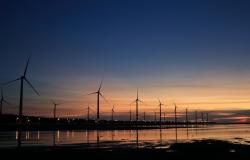Silver Linings for Non-Carbon Energy – If We Want to See Them

Scott Montgomery argues that there are no silver bullets, yet there are silver linings to our post-pandemic energy landscape.
There are few silver linings to the Covid-19 storm, but one of them is a ray of insight about a better energy future. The pandemic has hit the energy sector harder than almost any other. Effects have been profound and disruptive, but they’ve also been revealing. Two energy sectors have stood out for these effects: power generation and transport. There are reasons why this is highly meaningful.
First, these are the largest sectors of carbon emissions and lethal air pollution. Transportation has risen to this role in wealthy countries as they have moved away from oil and coal for electricity. Middle income and poorer nations, however, who are now the center of energy demand, have focused on expanding power production as a core part of development and have done so using cheap coal and natural gas most of all (some good representative profiles are offered by CarbonBrief). Admittedly, these are broad generalizations. But overall, and for the largest emitters—China, U.S., India, EU (~80% of global emissions)—the summary just given holds well.
Second, transport and power are where energy use is forecast to grow most rapidly. This underscores the issue of air pollution, especially in cities. Here, the massive public health impacts are now well-known and include millions of premature deaths every year. Even in wealthy nations, though estimates vary, air pollution-related deaths in Europe are diagnosed in the hundreds of thousands.
Third, despite these gloomy realities, there is good news: transport and power are linked for the long-term, so that improving the second will have massive benefit for the first. Such is one of the most hopeful and decisive results emerging from the past decade of energy innovation.
Consensus is now stronger than ever that the future of ground transport is electrification. Agreement comes not only from energy experts and starry-eyed futurists, but from key players: vehicle manufacturers, utilities, investment managers, oil companies, policy makers, and a growing portion of the public. Such is no minor melding of minds and wallets. Moreover, data to date (August) shows that the pandemic has brought a fall in vehicle sales pretty much everywhere except in electrics (EVs), which have risen, not least in Europe.
Ground transport includes private vehicles (cars, SUVs, small trucks), buses, commercial trucks, and heavy-duty trucks as well. All of these are now targets of electrification. This is because the cost of battery power has fallen as much as 90% in less than a decade, creating new commercial possibilities. Battery cost will continue to improve, though perhaps not at such a rate. Investment in bettering the technology, however, is larger than ever, with claims by a number of automakers than an affordable “million-mile battery pack” will soon arrive for personal vehicles, vs. the 200k-mile versions (~8-10 years) now common.
A Few Words about Electrification
Ideas about how rapidly electrification will be achieved vary. Those with practical minds agree it will not be sudden but instead a transition over decades and that light-duty vehicles will be the largest and most challenging target. As readers of this column may know, major automakers have announced dozens of new EV models for 2021-2025, hoping to get a jump on a market set to surge. This means cars, SUVs, and pickups, which, in wealthy nations account for up to 70% of transport emissions. The ever-rising popularity of SUVs worldwide adds much significance here.
Recent survey data, meanwhile, indicate a high level of interest in electric vehicles (EVs) among ordinary car buyers, including people of color. Governments at the local and national levels are putting in place a range of incentives for EVs of various kinds: tax write-offs, quota systems, mandates, and new air quality standards.
But there are real uncertainties, too, not least about charging infrastructure, the new target of “range anxiety.” The outlook here is a bit mixed and definitely complex. In Europe, there have so far been major differences among countries in building national vs. local charging networks. China, meanwhile, has been focusing on building large numbers of residential stations (apartment, condo complexes) and far fewer for public use.
The U.S., as expected, remains the “wild west” in this area, with some states (California) doing far more than others (Louisiana) and a tendency to politicize the issue (the state of Tennessee imposes an extra fee of $100/year on EVs). Common estimates are that it will require several $billion to install enough charging stations along major travel corridors near population centers to fully encourage a shift to EVs. If Democrats win the White House and gain control in Congress, this will likely be an achievable policy target. In the meantime, EV buyers will generally prefer charging at home (and moving out of Tennessee).
Though private vehicles get most of the attention, electrification of medium-duty diesel trucks is also underway. This will have rapid benefits for air quality. Their expanded use is encouraged (shall we say) by stricter emissions laws in Europe, California, and soon other US states. An important fact is that a large portion of this vehicle class resides in corporate and government fleets. This means big changes can happen fairly quickly and with fewer hurdles if top-level decision-makers are so inclined and if per-vehicle costs continue to fall. One example is Amazon, which has set a precedent in ordering 100,000 electric delivery vehicles for use starting in 2021. This may have helped urge UPS to order 10,000 for its own fleet.
All of which offers a pretty clear message. Electrification of land transport is happening even in the face of a global pandemic and low oil prices. A true global shift toward non-carbon electricity, then, would bring a massive double benefit in the domains of climate change and air quality, thus public health worldwide.
Power in a Pandemic
To some, this might seem like yesterday’s news. In a general sense, yes. But the pandemic has given it a good deal more clarity. That the air and visibility in cities worldwide has improved in spectacular fashion because of lockdowns has been lost on no one. Imagining that this could soon be the normal state of affairs has real psychological force, including for young people who may be thinking about their future health and that of children they may have.
So how has power generation responded to the crisis? Contrary to what was initially expected, demand for electricity dropped as much as 20% or more during lockdown and remained up to 10% below 2019 levels after partial lifting of restrictions. It turns out that power consumption by office buildings, commercial sites, restaurants, and so on, outweighed increases from people staying at home. This highlights a key fact: cities are the center of global power demand.
Lockdown accelerated a number of electricity use trends by forcing daily life online. Work, meetings, conferences, classes, and many other interactions went remote, and not all of this will return to past normal. Shopping received an enormous online boost, and the advantages (e.g. time saving, convenience, etc.) argue this has set a new pattern too. Forms of
automation, which now involve many areas of the service sector, have gained value because of the pandemic.
Reliance on electricity in general has deepened and is deepening. The global pattern now evident is for it to eventually become the single overriding energy dimension for human existence. EVs will be a major addition to this in terms of societal penetration. The trend and its various elements have so far been concentrated in wealthy countries. Their advance in certain middle income nations (e.g. Argentina) suggests they will soon spread to cities worldwide. It will be a core aspect of urbanization everywhere, and, because of this, a core security issue even more than today.
Which Sources?
This brings to the fore what the pandemic has revealed about primary energy sources.
Data and analysis presented by the International Energy Agency (IEA) shows detailed changes for the electricity mix in China, India, the EU, and U.S. during the first six months of 2020. Overall, the sudden drop in power consumption hit coal and, to a lesser extent, natural gas power plants hardest. This isn’t entirely surprising. These sources generally have higher operating costs, as they must pay for a continuous supply of fuel. In the U.S. and European countries, coal use for power generation fell most of all, since abundant supply of natural gas has kept prices low, particularly in the U.S.
The result is that pandemic has accelerated the pattern of gas replacing coal. This has been most true in western nations but also in parts of Asia, including China. Substituting gas for coal has been strongly promoted in policy circles as a way to reduce emissions and pollution. There are two major risks here. One is price volatility: the past five years indicate there are no guarantees whatsoever that gas will remain cheap going forward. A second risk is that trading coal for gas has a limit for its benefits. At a particular point, emissions will stop falling and rise thereafter. Depending on how reliant a nation is on coal, the inflection point may be distant (China, India at present) or already passed (U.S. and EU).
Other important conclusions that come from the IEA data are these:
- In all four regions/nations, coal use declined the most, up to 10% or more, with some reduction in natural gas in China and the EU (not the US, where gas is especially cheap). The pandemic, therefore, is expected to reduce most of all the world’s dependence on fossil fuels for electricity.
- Supply from renewables, including hydropower, grew everywhere as a percentage of the total. This came from existing installations, whose supply was not decreased but maintained (its curve on a graph of % supply vs. time is the reverse of that for coal). The IEA expects real growth in their supply during the pandemic, due to low operating costs for solar and wind and to their priority use mandated in a number of countries.
- The most stable source, compensating for the variability introduced by more renewable use and the decline in coal, was nuclear. This showed a slight decline of a few percent overall, partly related to shutdown of the Fessenheim Plant, France’s oldest. The IEA emphasizes the stabilizing role nuclear has played during the pandemic, both as a reliable base load source and in load-following.
- Global investment in the power sector has been especially consistent and stable, compared to more volatile levels for hydrocarbon fuels. Such investment has been highest for renewables and electricity networks (mainly grid systems) and lowest by a factor of 10 for nuclear.
What Can Be Learned?
One unavoidable conclusion is that renewable sources of electricity have made enormous strides. From an insignificant presence in the early 2000s, they have become a major contributor to power generation worldwide. For actual numbers on this, BP’s Statistical Review of World Energy 2020 shows that, when we include hydropower, renewables now account for 20% - 35% of total generation in every part of the globe except the oil/gas-rich Middle East and CIS (Russia-Central Asia).
There has been much wringing of hands and falling on swords about how such progress is far short of what must be achieved. Roughly $4 trillion (US) of investment since 2002 has not moved the world substantially to renewable power, goes the complaint. Nations must get truly serious about emissions and rapidly shift to clean energy which is now cheap and affordable. The way forward is obvious.
But no. Energy responses to the pandemic do not support this. They highlight that such agonistes are born from the belief that renewables—meaning, in most cases, wind and solar only—must bear the burden for a non-carbon energy future. The IEA data underscores that these technologies need and work best combined with more reliable, dispatchable sources that are not weather (and thus climate) dependent. Renewables have limitations in what they can provide, as all sources do. In their current form, moreover, they are very young technologies, less than two decades old. Expecting them to fully power a world of massive and expanding economies, cities of 20 million or more, huge industries, militaries, and so on, is no more realistic than expecting electric vehicles to replace all others worldwide within five years.
Climate change and the pandemic together have made this especially clear. This comes from California, where an extreme heat wave and a new round of wildfires have led to rolling blackouts affecting millions of people. The heat adds considerably to health risks, both by causing illness and by accentuating existing conditions in people. Loss of power, even for a brief time, means an increase in risk for many recovering from Covid-19 infection and those who will require non-hospital care in coming days. The heat wave affecting most of the state also forces people out of their homes when power goes out and air conditioning stops. Utilities have tried to keep outages short, to 30 minutes or less, but this hasn’t worked when the gap between power demand and supply is too large.
A major reason for this gap is California’s policy of expanding solar and wind while progressively closing natural gas and nuclear. Climate change has helped increase the frequency of heat waves in the state, with high temperatures continuing after dark, when there is no solar generation and winds in much of the state are weaker (California is not the North Sea). The size of the power demand involved (many gigawatts) makes utility-scale battery storage infeasible. This part of the über-faith in renewables is also fraught with a tendency to turn away from limitations to this and other storage technologies, which utilities have begun to realize through actual experience (for all its headline-grabbing, the Tesla “powerbank” in South Australia is a test tube experiment compared to California’s needs; sorry Mr. Musk). In plain terms, storage is a necessary element for solar/wind systems but not a replacement for actual reliable generation. The problems in California were foreseeable: it has been the largest importer of power from other states for years—in simple terms, its renewables policy exists partly on the back of more reliable sources outside its borders.
Both heat waves and wildfires have major impacts on wind and solar generation. Heat waves come with high atmospheric pressures that greatly reduce wind occurrence, while wildfires produce smoke that blocks sunlight, with large fires such as those that now occur almost yearly in California and other portions of the western US able to create such impacts over many thousands of square miles. The realities of limitation for any energy source are not criticisms. They are facts that need to be taken into account for any plan, program, or policy for decarbonization. The idea that a small number of sources—be it solar/wind, natural gas/coal, or nuclear alone--will be able to run the world with all its inexorable geographic, climatological, geologic, and economic diversity is misguided at best and, at worst, a barrier to real progress.
As the IEA states, a serious and practical way to make major progress in non-carbon power generation is to combine expansion of both renewable (including hydro) and nuclear generation. A particularly large hurdle to this is the very low level of overall investment in nuclear, particularly in wealthy nations and especially in advanced nuclear technologies. The addition of hydrogen as an energy source (an idea that has returned from a period of disenchantment in the 2000s) may fit well into such an expansion. This is especially true in the case of nuclear, given the level of heat generated. A number of efforts with government support to test this idea using existing reactors are now underway in the US.
Final Statement
As often said, a crisis is a terrible thing to waste. Covid-19 has helped clarify a key part of the world’s energy situation. Electricity will be an ever-growing part of the future, and this will include the vehicles we use for mobility on land. It provides a core opportunity to greatly lower emissions and lethal air pollution in coming decades—two huge benefits, and not just for humans. The pandemic has highlighted the flexibility and resilience of non-carbon power generation that combines variable and reliable sources, namely renewables and nuclear power.
This is an essential insight that should not be squandered.
The IEA, as well as the IPCC (Intergovernmental Panel on Climate Change), a majority of US scientists, and a growing number of environmental groups, endorse both renewable (again, with hydro included) and nuclear energy as essential non-carbon sources that can be expanded fairly rapidly. Neither can do the necessary work alone, and even in combination they will need help from other sources in the long-term, as dependence on fossil energy declines.
For those who believe renewables like wind and solar are too weak to ever be major sources of electricity, it would be helpful to look at actual data on their use (the mentioned BP report is a reasonable place to start). For those who think these sources can and must power the future alone, an exploration of their technical limits might make sense. And for those who continue to feel (as I once did) that nuclear is too hazardous or expensive or its waste is too difficult to store, there has never been a more important time to educate oneself about this source from knowledgeable scientists and (if Chernobyl or Fukushima is your worry) medical professionals.
In sum, the overriding message to be gained from the impact of Covid-19 on global energy goes back to H.L. Mencken’s observation that there is always a clear solution to every human problem—neat, simple, plausible, and wrong.

